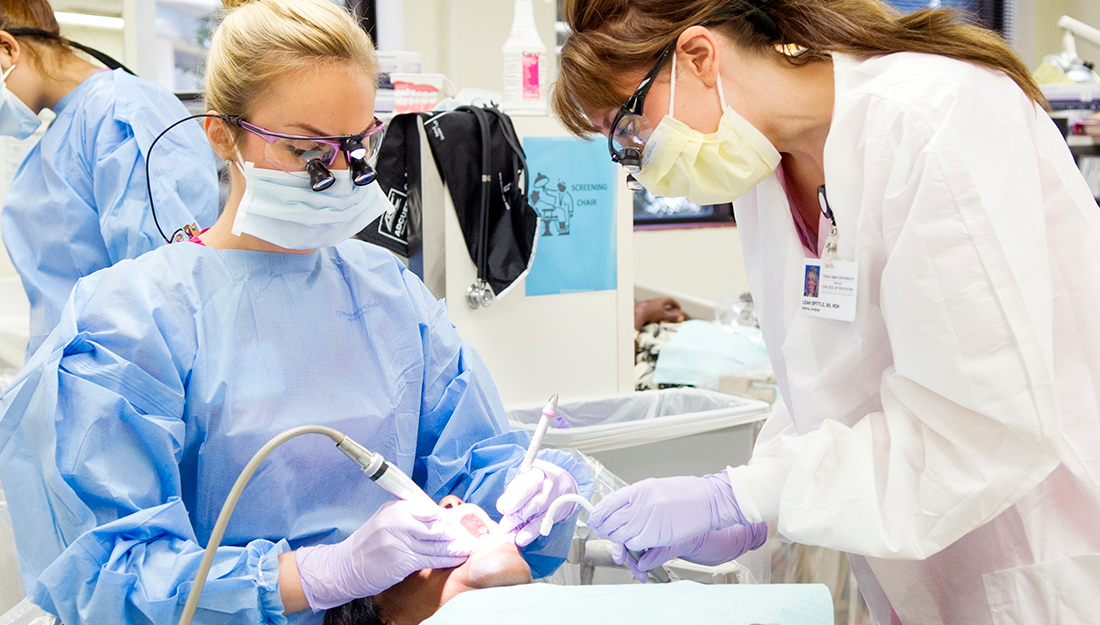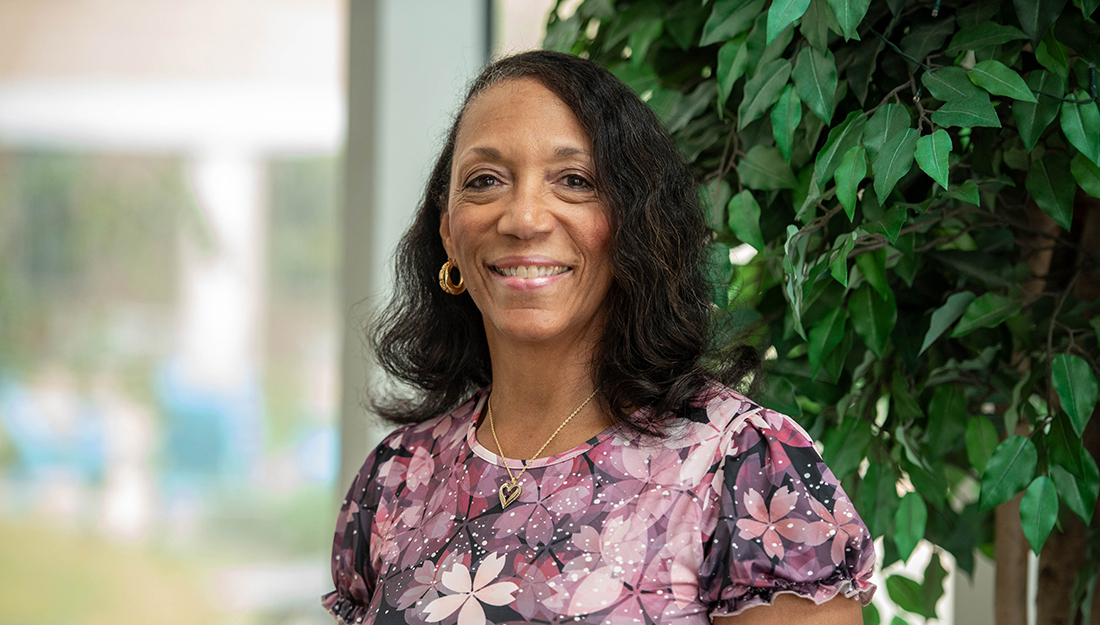Dental hygiene alumni on the leading edge of health care administration

In 1955, Caruth School of Dental Hygiene’s first class of 32 students began a journey that would lead to their distinction as the first dental hygiene graduates in the state of Texas.
Six decades later, clinical care is still a primary educational focus, but the dental hygiene program has evolved in the years since its founding — expanding to a bachelor’s degree from a two-year certificate program, adding advanced degree options and laying the foundation for diverse career paths in the profession and beyond.
As emphasis on interprofessional care helps bridge the health professions, several Caruth alumni are among those forging new territory, fulfilling leadership roles in hospital clinics and senior-level administration positions for some of Dallas-Fort Worth’s pre-eminent health care institutions.
These dental hygiene master’s graduates, all unique individuals, possess commonalities that enhance their success: emphasis on teamwork, a dental-centered knowledge base and a compassionate approach to patient care acquired during their time at Texas A&M University Baylor College of Dentistry.
Meet some of these movers and shakers.
DIANNA PRACHYL ’94, ’00
Senior vice president of community health, JPS Health Network in Tarrant County
Oversees: 41 community clinic sites, including six dental clinics
Dianna Prachyl received exciting news in 2006: After six years as clinical manager of dental services at Children’s Medical Center Dallas, she was getting a promotion. It was a move that would take her away from the dental hygiene realm to become director of ambulatory services.
“When I was first introduced to some of the surgeons as their director, one of them said, ‘I don’t want a nurse to be director of my clinic.’” Prachyl’s supervisor had a brusque response for him: “That’s great, she’s not a nurse — she’s a dental hygienist.”
“I will never forget him saying that that day,” Prachyl recalls. But on a serious note, “Part of developing a good relationship with a practitioner is never saying no. It’s ‘tell me more,’” she says. “I always ask them, ‘What do you need, and how can I help you get there?’”
It’s that mindset that has taken Prachyl from Dallas to a different leadership role in Fort Worth with John Peter Smith Health Network, where as senior vice president of community health, she oversees dozens of clinics — dental, medical, outpatient, school-based and specialty — across Tarrant County.
Prachyl visits one location in Arlington on a Wednesday in early July. A vacant grocery market and pet store were transformed into this glistening “patient-centered medical home” concept: an interprofessional mix of dentistry, primary care, optometry, women’s health, neurology, behavioral health and more. Eligibility counselors are on hand to assist with financial counseling or guidance.
“It’s the best way to ensure at-risk populations get the care they need,” Prachyl says of the Arlington center, which serves more than 80,000 patients each year.
Operating this center well — along with the 40 other community clinic sites under Prachyl’s purview — requires a delicate dance in understanding the needs of dentists and physicians while being ever mindful of the patient experience. As the safety-net hospital system in Tarrant County, JPS Network has 1 million patient encounters per year, many dealing with psychosocial needs in addition to medical concerns. It offers the opportunity for constant expansion in terms of patient care. The only challenge is time: There just simply isn’t enough of it.
A team approach helps.
“We are used to working with teams,” Prachyl says of dental hygienists. “That’s another important concept when you move into the larger health care realm. I am one person, so I have to have a whole lot of people moving in the same direction to meet the needs of our patients, providers and community.”
STACY PETIT REDDEN ’10
Practice administrator, Children’s Health Dallas
Oversees: dental and orthodontic clinics
It’s 11 a.m., and this particular Tuesday is an anomaly. There are just two patients left at the Acton Center for Pediatric Dentistry at Children’s Health, a bright, winding space featuring curved walls dotted with cutout stars, triangles and circles. It was teeming with activity just an hour earlier.
On average, up to 45 pediatric patients come through these doors a day, 80 percent of whom are dealing with a medical complexity or developmental disorder. The Children’s Medical Center Dallas affiliation — and proximity — offers extra security against unexpected emergencies during appointments, and the clinic is one of the only dental resources available to this patient population. Residents from TAMBCD’s pediatric dentistry graduate program treat patients, and the pediatric dentistry department chair is the director of the dental service. Attending faculty from the department are always present.
The orthodontic clinic at the hospital specializes in assisting patients with craniofacial issues such as cleft lip and palate. TAMBCD has a presence there as well; a craniofacial team member serves on the orthodontic faculty.
At the center of it all is Stacy Petit Redden. In her role as practice administrator of the dental and orthodontic clinics, Redden relies on her dental-specific knowledge for staff and patient interaction.
“It’s a different language,” Redden explains. “If you don’t have the background of being in a clinic or working with teeth in general, you won’t understand what people are talking about.
“It also helps me when I have that conversation with parents who are confused or upset about something. A lot of times they don’t want to hear from my staff; they want to talk to the manager. It’s having that knowledge, that background,” she adds. The expertise also means the administrator can talk to pediatric dentistry residents in a language they understand.
Regents Professor and former pediatric dentistry chair N. Sue Seale ’70, ’72, D.D.S., M.S.D, first recognized the need decades ago when she championed the idea of an administrative track within the master’s program then being developed by Caruth dental hygiene faculty.
Redden exemplifies a longstanding connection between TAMBCD and Children’s Health. Two previous directors also have ties to the Caruth School of Dental Hygiene: Joy Parker ’03, ’06 and Prachyl. The understanding of health care administration gleaned from a dental hygiene master’s degree, something all of them possess, is an added bonus.
MARIA ANDERSON ’94, ’01
Dental clinic manager, Texas Scottish Rite Hospital for Children
Oversees: outpatient dental clinic
Visitors to “The Ranch” — the outpatient dental clinic at Scottish Rite, a pediatric orthopedic hospital in Dallas — follow a winding lasso painted on the floor to reach their dental chairs. The distinct sensation they are in a movie theater rather than a clinic or hospital might have something to do with the popcorn machine in the lobby, a permanent fixture at Scottish Rite.
“The first thing the kids ask is, ‘Can I have popcorn?’” says Snehal Patel, a hygienist in the clinic and a member of Maria Anderson’s team. “Yes,” she’ll respond, “but you have to promise me that you’ll wait 30 minutes before you start eating it because we just put fluoride varnish on your teeth.”
For the past 10 years, Anderson has overseen the clinic, where 2,000 patients come through the doors each year. These youngsters have orthopedic conditions and are often not mobile or verbal. All of the patients are seen by a primary care service at the hospital where Anderson, the liaison between their physicians and her team, ensures that the patients’ medical conditions are not compromised during dental treatment.
TAMBCD pediatric dentistry residents provide the dental care at Scottish Rite. In addition to a full-time staff of two hygienists and two dental assistants, dental hygiene students from across the metroplex rotate through the clinic. Anderson and her team provide instruction to these students on treating patients with complex conditions.
The training helps students become more comfortable caring for pediatric patients with special needs, which means a larger referral base for Scottish Rite patients as they age out of the hospital’s care.
Hygienists are well suited for this role, Anderson says, and it’s not just because of clinical training and self-discipline.
“We have a compassionate side in that we tend to like that personal relationship and one-on-one,” she says.
Susan McGuire, D.D.S., assistant director of the dental clinic at Scottish Rite and assistant professor in pediatric dentistry at TAMBCD, has worked with Anderson for five years.
“Applying Maria’s background to this clinic has made a lot of other departments here at the hospital aware of what we do and how the services we provide integrate with what they are doing,” says McGuire. Anderson encourages them to be proactive, reminding surgical teams to have patients receive dental clearance from the outset of care, rather than waiting until right before surgery.
“Maria is definitely an advocate for the dental service,” McGuire says, “and how even in young children, dental health and their systemic health go hand in hand.”
Revamped master’s degree for health professionals
In the mid-1990s, Janice DeWald ’95, B.S.D.H, D.D.S., M.S., noticed a concerning trend. She had recently been appointed as director and chair of the Caruth School of Dental Hygiene, a vantage point that heightened her awareness of an educator shortage in the field. She needed only a bit of simple math to realize the extent of the problem: There were just seven programs in the country offering master’s degrees in dental hygiene at the time, and not one of them was in Texas.
With wholehearted encouragement from N. Sue Seale ’70, ’72, D.D.S., M.S.D., then professor and chair of pediatric dentistry, who knew advanced education could also equip dental-savvy administrators to direct hospital-based dental clinics, DeWald sprung to action. After developing a rationale for a graduate dental hygiene program and collaborating with faculty to develop a curriculum, Caruth accepted its first graduate-level class in 1997. Students could choose from one of two tracks: education or administration.
Fast forward to 2011: Dental school administrators, in collaboration with Texas A&M Health Science Center, began looking at opportunities to form a new graduate program — one that encompassed all health disciplines to reflect new patient care models. The new curriculum, Master of Science in Education for Healthcare Professionals, means dental hygiene graduate students complete their core graduate courses with students from all TAMHSC components, including dentistry, medicine, nursing, pharmacy and public health, with practicums focusing on their chosen profession.
While the original dental hygiene graduate degree has folded into this new program — the last dental hygiene graduate degree was awarded in May 2015 — many of its original elements remain. Coursework such as contemporary health care issues, assessment and health policy are still taught, giving dental hygiene graduate students a groundwork to pursue teaching or administration.
Nine A&M Baylor College of Dentistry students are enrolled in the revamped graduate program, and Leah Spittle ’11 is one of three who pursued the dental hygiene practicum.
“I went into it thinking the degree was mostly going to coincide with my field. I was surprised in a positive way that it didn’t,” says Spittle, who after several years in private practice decided to pursue her master’s in order to teach.
“One of our classes was taught by a nurse. Another was taught by a pediatric physician. I expected to be in my same dentistry bubble, but I was excited that I had to expand my knowledge and understanding of other health care fields. This helped to open my mind to how others see things.”
Media contact: media@tamu.edu


